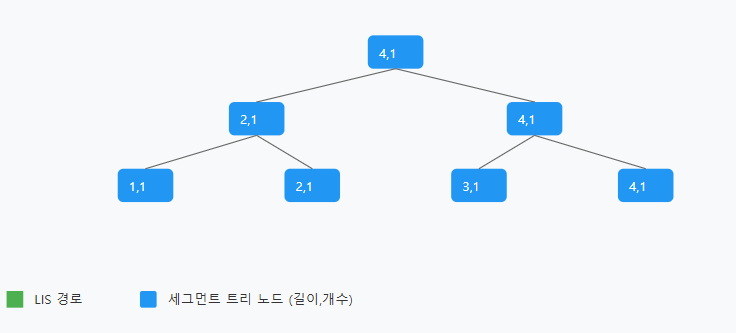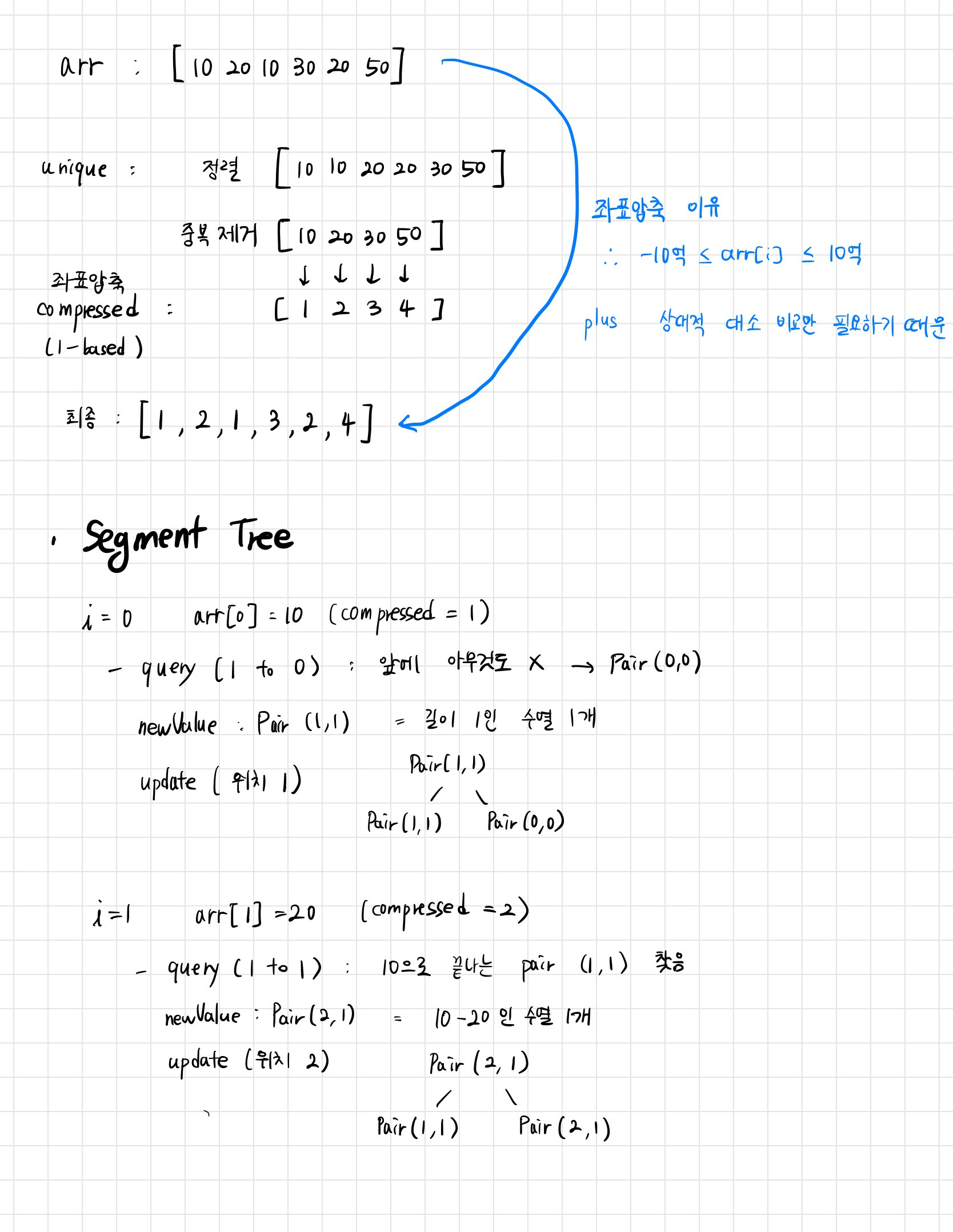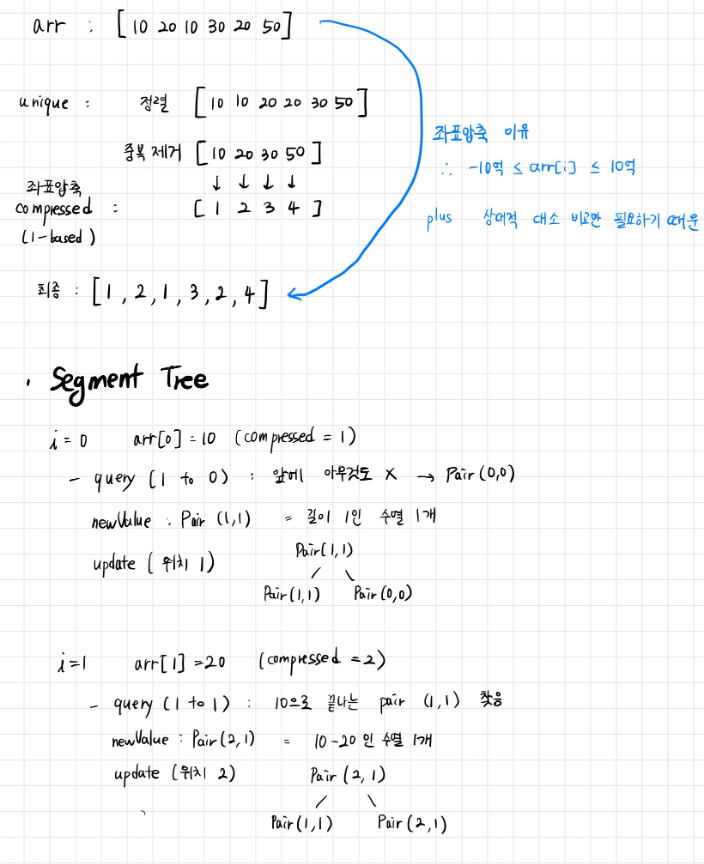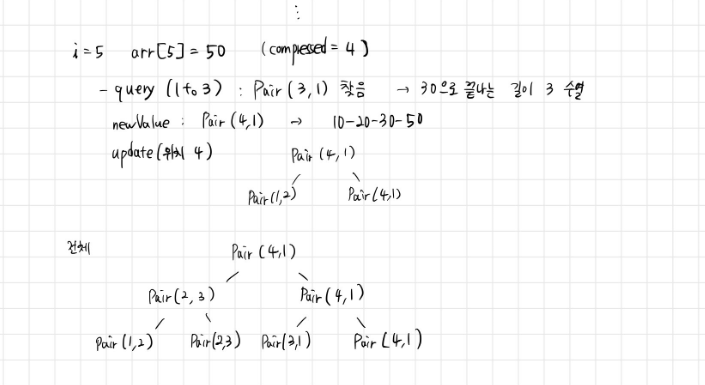BOJ_17411_가장 긴 증가하는 부분 수열 6 (Java)
[Platinum II] 가장 긴 증가하는 부분 수열 6 - 17411
성능 요약
메모리: 495940 KB, 시간: 3084 ms
분류
이분 탐색, 자료 구조, 가장 긴 증가하는 부분 수열: O(n log n), 세그먼트 트리
제출 일자
2025년 1월 17일 03:38:31
문제 설명
수열 A가 주어졌을 때, 가장 긴 증가하는 부분 수열과 개수를 구하는 프로그램을 작성하시오.
예를 들어, 수열 A = {10, 20, 10, 30, 20, 50} 인 경우에 가장 긴 증가하는 부분 수열은 A = {10, 20, 10, 30, 20, 50} 이고, 길이는 4이고, 1개이다. A = {10, 20, 30, 10, 20, 30}인 경우에는 가장 긴 증가하는 부분 수열의 길이는 3이고, 4개가 있다.
입력
첫째 줄에 수열 A의 크기 N (1 ≤ N ≤ 1,000,000)이 주어진다.
둘째 줄에는 수열 A를 이루고 있는 Ai가 주어진다. (-1,000,000,000 ≤ Ai ≤ 1,000,000,000)
출력
첫째 줄에 수열 A의 가장 긴 증가하는 부분 수열의 길이와 개수를 출력한다. 개수는 매우 커질 수 있기 때문에 109+7로 나눈 나머지를 출력한다.
문제 풀이
접근 방식
일반적인 LIS는 이분 탐색을 사용하여 O(N log N)에 해결할 수 있다. 하지만 이 문제는 개수도 세야 하므로, 세그먼트트리를 사용해야한다.
세가지 전략으로 접근해보겠다.
- 좌표 압축
- 세그먼트 트리
- 개수 세기를 위한 DP적 접근
1. 좌표 압축
1
2
3
TreeSet<Integer> uniqueSet = new TreeSet<>();
for(int n : arr) uniqueSet.add(n);
ArrayList<Integer> unique = new ArrayList<>(uniqueSet);
- Why?
- 입력값의 범위가 -10^9부터 10^9까지로 매우 큼.
- 세그먼트 트리를 만들기 위해서는 이 범위를 압축해야 함.
- How?
- TreeSet으로 중복을 제거하고 정렬.
- 각 숫자를 1부터 시작하는 인덱스로 매핑.
세그먼트트리
1
2
3
4
5
6
7
8
static class Pair {
int length; // LIS의 길이
long count; // 해당 길이를 가진 LIS의 개수
public Pair(int length, long count) {
this.length = length;
this.count = count;
}
}
- length: 현재까지의 최대 LIS 길이
- count: 해당 길이를 가진 LIS의 개수
1
2
3
4
5
static Pair merge(Pair a, Pair b) {
if(a.length > b.length) return a;
else if(a.length < b.length) return b;
return new Pair(a.length, (a.count + b.count) % MOD);
}
- 세그먼트 트리의 각 노드는 Pair 객체를 저장.
- merge 함수는 두 구간의 정보를 합칠 때 사용 :
- 길이가 다르면 더 긴 쪽을 선택
-
길이가 같으면 개수를 더함 (MOD 연산)
1 2 3 4 5
for(int i=0; i<N; i++) { Pair curr = query(1, compressed[i]-1, 1, uniqueSize, 1); Pair newValue = new Pair(curr.length + 1, Math.max(curr.count, 1)); update(compressed[i], newValue, 1, uniqueSize, 1); }
arr 수열의 각 숫자를 순회하면서 :
- 현재 숫자보다 작은 모든 숫자들 중에서 최대 LIS 정보를 가져온다.
- 현재 숫자를 포함하는 새로운 LIS를 만든다. ( 그 개수 그대로 하나 붙이는것임은 자명하다)
- 세그먼트 트리를 업데이트.
단계별 과정
- Step 1: 첫 번째 숫자 (10)
1
2
3
4
5
6
7
8
9
10
11
현재 숫자: 10 (압축값: 1)
1. 이전 작은 숫자들 조회 (query(1, 0))
- 결과: length = 0, count = 0 (아무것도 없음)
2. 새로운 상태
- length = 1 (0 + 1)
- count = 1 (새로운 수열 시작)
3. 세그먼트 트리 업데이트
- 위치 1에 (length=1, count=1) 저장
현재까지 찾은 LIS들:
- {10} (길이 1, 개수 1)
- Step 2: 두 번째 숫자 (20)
1
2
3
4
5
6
7
8
9
10
11
12
현재 숫자: 20 (압축값: 2)
1. 이전 작은 숫자들 조회 (query(1, 1))
- 결과: length = 1, count = 1 (10으로 끝나는 수열)
2. 새로운 상태
- length = 2 (1 + 1)
- count = 1 (이전 수열에서 이어짐)
3. 세그먼트 트리 업데이트
- 위치 2에 (length=2, count=1) 저장
현재까지 찾은 LIS들:
- {10} (길이 1, 개수 1)
- {10, 20} (길이 2, 개수 1)
- Step 3: 세 번째 숫자 (10)
1
2
3
4
5
6
7
8
9
10
11
12
13
현재 숫자: 10 (압축값: 1)
1. 이전 작은 숫자들 조회 (query(1, 0))
- 결과: length = 0, count = 0 (더 작은 수 없음)
2. 새로운 상태
- length = 1 (0 + 1)
- count = 1 (새로운 수열 시작)
3. 세그먼트 트리 업데이트
- 위치 1의 상태 유지 (merge 결과 변화 없음)
현재까지 찾은 LIS들:
- {10} (길이 1, 개수 1)
- {10, 20} (길이 2, 개수 1)
- {10} (새로운 시작점)
- Step 4: 네 번째 숫자 (30)
1
2
3
4
5
6
7
8
9
10
11
12
13
현재 숫자: 30 (압축값: 3)
1. 이전 작은 숫자들 조회 (query(1, 2))
- 결과: length = 2, count = 1 ({10, 20}으로 끝나는 수열)
2. 새로운 상태
- length = 3 (2 + 1)
- count = 1 (이전 수열에서 이어짐)
3. 세그먼트 트리 업데이트
- 위치 3에 (length=3, count=1) 저장
현재까지 찾은 LIS들:
- {10} (길이 1)
- {10, 20} (길이 2)
- {10, 20, 30} (길이 3, 개수 1)
- Step 5: 다섯 번째 숫자 (20)
1
2
3
4
5
6
7
8
9
10
11
12
13
14
현재 숫자: 20 (압축값: 2)
1. 이전 작은 숫자들 조회 (query(1, 1))
- 결과: length = 1, count = 1 (10으로 끝나는 수열)
2. 새로운 상태
- length = 2 (1 + 1)
- count = 1 (이전 수열에서 이어짐)
3. 세그먼트 트리 업데이트
- 위치 2의 상태 갱신 (merge로 count 합산)
현재까지 찾은 LIS들:
- {10} (길이 1)
- {10, 20} (길이 2)
- {10, 20, 30} (길이 3)
- {10, 20} (새로운 경로)
- Step 6: 마지막 숫자 (50)
```현재 숫자: 50 (압축값: 4)
- 이전 작은 숫자들 조회 (query(1, 3))
- 결과: length = 3, count = 1 ({10, 20, 30}으로 끝나는 수열)
- 새로운 상태
- length = 4 (3 + 1)
- count = 1 (이전 수열에서 이어짐)
- 세그먼트 트리 업데이트
- 위치 4에 (length=4, count=1) 저장
최종 LIS들:
- {10, 20, 30, 50} (길이 4, 개수 1)
1
2
3
3. 세그먼트 트리 최종
각 위치는 해당 값을 마지막으로 하는 LIS의 정보를 저장:
위치 1 (값 10): length=1, count=1 위치 2 (값 20): length=2, count=1 위치 3 (값 30): length=3, count=1 위치 4 (값 50): length=4, count=1
1
2
3
4
5
6
7
8
9
10
11
12
13
14
15
16
17
18
19
20
21
22
23
24
25
26
27
28
29
30
31
32
33
34
35
36
37
38
39
40
41
42
43
44
45
46
47
48
49
50
51
52
53
54
55
56
57
58
59
60
61
62
63
64
65
66
67
68
69
70
71
72
73
74
75
76
77
78
79
80
81
82
83
84
85
86
87
88
89
90
91
92
93
94
95
96
97
98
99
100
101
102
103
104
105
106
107
108
109
110
111
112
113
114
115
116
117
118
119
120
121
122
123
124
125
126
127
128
129
130
131
132
133
134
135
136
137
138
139
140

> ## 코드
```java
/**
* Author: nowalex322, Kim HyeonJae
*/
import java.io.*;
import java.util.*;
public class Main {
static final int MOD = 1000000007;
static class Pair{
int length;
long count;
public Pair(int length, long count){
this.length = length;
this.count = count;
}
}
static Pair merge(Pair a, Pair b){
if(a.length > b.length) return a;
else if (a.length < b.length) return b;
// 같은 길이일때는 count를 더함
return new Pair(a.length, (a.count + b.count) % MOD);
}
static BufferedReader br;
static BufferedWriter bw;
static StringTokenizer st;
static int N, arr[], compressed[];
static Pair segment[];
public static void main(String[] args) throws Exception {
new Main().solution();
}
public void solution() throws Exception {
br = new BufferedReader(new InputStreamReader(System.in));
// br = new BufferedReader(new InputStreamReader(new FileInputStream("src/main/java/BOJ_17411_가장긴증가하는부분수열6/input.txt")));
bw = new BufferedWriter(new OutputStreamWriter(System.out));
N = Integer.parseInt(br.readLine());
arr = new int[N];
st = new StringTokenizer(br.readLine());
for (int i = 0; i < N; i++) {
arr[i] = Integer.parseInt(st.nextToken());
}
// 좌표압축
TreeSet<Integer> uniqueSet = new TreeSet<>();
for(int n : arr) uniqueSet.add(n);
ArrayList<Integer> unique = new ArrayList<>(uniqueSet); // 중복제거
compressed = new int[N];
for(int i = 0; i < N; i++){
int pos = binarySearch(unique, arr[i]);
compressed[i] = pos + 1; // 1-based
}
int uniqueSize = unique.size();
segment = new Pair[4*uniqueSize];
for (int i=0; i<4*uniqueSize; i++) {
segment[i] = new Pair(0, 0);
}
for(int i=0; i<N; i++){
// 지금i위치보다 앞에있는 작은수들 중 LIS 찾기
Pair curr = query(1, compressed[i]-1, 1, uniqueSize, 1);
/*
지금위치i까지 포함해서 길이 1 증가
count가 0일땐 새로운수열 시작 (1)
count가 0아닐땐 이전까지 count 다 더함
*/
Pair newValue = new Pair(curr.length + 1, Math.max(curr.count, 1));
update(compressed[i], newValue, 1, uniqueSize, 1);
}
Pair result = query(1, uniqueSize, 1, uniqueSize, 1);
bw.write(result.length + " " + result.count + "\n");
bw.flush();
bw.close();
br.close();
}
private int binarySearch(ArrayList<Integer> unique, int target) {
int left = 0, right = unique.size() - 1;
int res = 0;
while(left <= right){
int mid = left + (right-left)/2;
if(unique.get(mid) >= target) {
res = mid;
right = mid - 1;
}
else left = mid + 1;
}
return res;
}
/*
구간 [left, right]에서 최댓값 찾기
*/
static Pair query(int left, int right, int start, int end, int node){
if(left > end || right < start) return new Pair(0, 0);
if(left <= start && end <= right) return segment[node];
int mid = start + (end-start)/2;
Pair leftRes = query(left, right, start, mid, node*2);
Pair rightRes = query(left, right, mid+1, end, node*2 + 1);
return merge(leftRes, rightRes);
}
/*
pos 위치를 value로 업데이트
*/
static void update(int pos, Pair value, int start, int end, int node){
if(pos > end || pos < start) return;
if(start == end){
segment[node] = merge(segment[node], value);
return;
}
int mid = start + (end-start)/2;
update(pos, value, start, mid, node * 2);
update(pos, value, mid+1, end, node * 2 + 1);
segment[node] = merge(segment[node * 2], segment[node * 2 + 1]);
}
}


